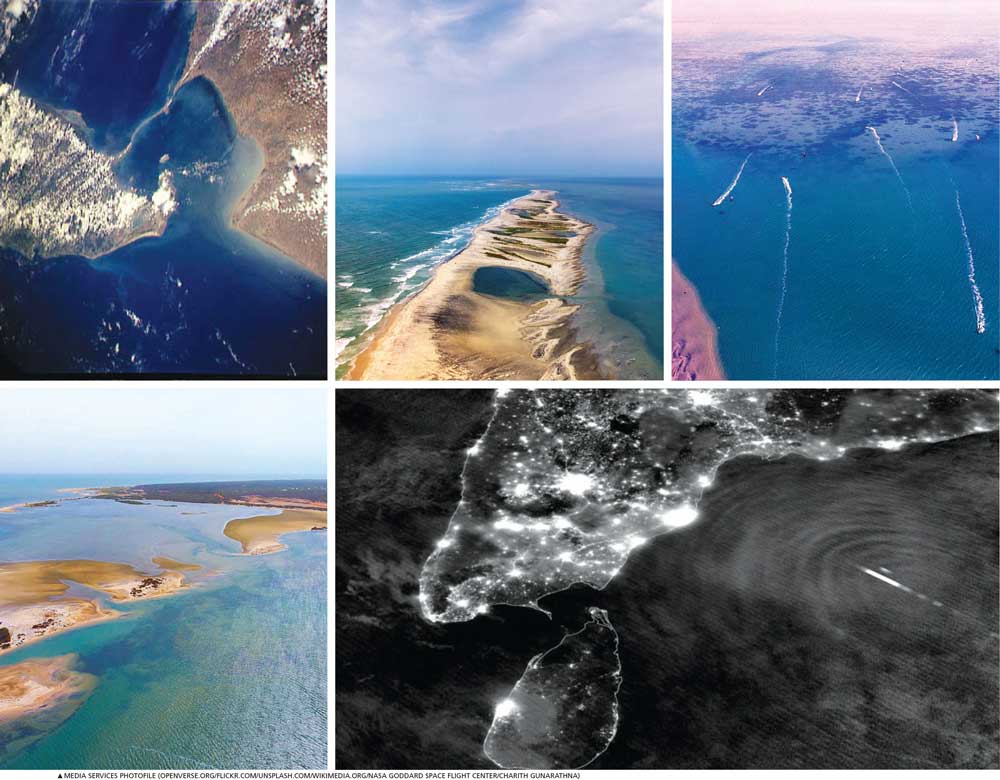A BRIDGE (NOT) TOO FAR
Wijith DeChickera stands poised at the edge of the Palk Strait, balancing the past, present and future before testing the waters – for a channel crossing

All the best maps show it in graphic detail. An iconic image taken by US space agency NASA’s Gemini 11 mission in September 1966 offers a breathtaking view from space of ‘Mother India’ connected poignantly to a foetal Sri Lanka, linked umbilically by a navel cord of sorts.
And in the hearts and minds of myriad Sri Lankans and Indians, Adam’s Bridge (as it is arguably best known) lies in shallow waters of the Palk Straits, captive to a deep dream of primordial connectivity between land and ocean.
THE PAST In antiquity, this chain of natural limestone shoals constituted a channel crossing of sorts for denizens of two land masses, tenuously linked by a series of parallel ledges of sandstone punctuated by small reefs.
At low water mark – when the Indian Ocean that washes over it lay shallow – Adam’s Bridge for over a hundred millennia offered an intermittent land connection between the subcontinent and the tear shaped island due south of it, according to geological evidence.
And in the minds of ornithologists, such a natural connection supports the vicariance model of allopatric speciation of birds in the Indian subcontinent.
THE PRESENT Of late however, models to develop this intriguing piece of real estate have been distinctly less birdbrained than those claiming that the 48 kilometre long structure is man-made!
Since 1956, India’s government mooted multiple projects to enable mariners to navigate the notoriously shallow waters of the Palk Strait, which necessitate vessels from West to East circumnavigating Sri Lanka – a detour of 400 nautical miles and waste of 30 shipping hours.
Such plans built on 18th century geographer Major James Rennell’s proposal that “a navigable passage could be maintained by dredging” the strait of Rameswaram – it was rejected on the grounds that the idea came from a mere junior colonial officer.
A series of more detailed marine surveys offered a succession of Indian governmental committees fodder for further proposed projects spanning the gamut from alignments of a canal project, through carving out land-based passages to creating a channel for ships across the Palk Strait by dredging the shallow ocean floor near Dhanushkodi at India’s southernmost tip – the controversial and politically sensitive Sethusamudram Shipping Canal Project of 2005.
Today, the talk of the town is a proposed land route to be built along Adam’s Bridge – also known as Rama’s Bridge (Rama Setu), which is an allusion to the legendary virtuous prince of India, who crossed the channel using a makeshift construction engineered by Hanuman’s mythical ‘monkey army’ to rescue his wife Sita from Ravana the villainous ‘demon king of Lanka– a narrative in the ancient Sanskrit epic Ramayana.
THE FUTURE Whether Sri Lanka fully realises it or not yet, the economy of an ailing island nation stands poised to gain from such a reinvigorated connectivity between typically ambivalent neighbours.
This too from more than merely capitalising on the Rama-Ravana nexus to boost substantially a projected US$ 1.5 billion, 1.5 million visitor tourism industry that already rakes in not insignificant shekels from Ramayana-based travel, and adventure offerings at a host of sites from Sithawaka and Sita Eliya through Rumassala to Ravana Ella (a.k.a. Ella).
For one, the proposed multipurpose connectivity conduit will allow Sri Lanka to access the booming multimillion-dollar vehicle manufacturing assemblies of Tamil Nadu.
This is only one of many thriving industries in the southern region of the potentially lucrative subcontinent to which global production networks (GPNs) are moving as India becomes another major cog in the regional GPN arena for raw materials, finished products and trade.
For another, the construction of a multifaceted land bridge would boost general, modern, high frequency trade models and volumes between the two countries, by signing comprehensive economic partnership agreements (CEPAs) that build on the back of a strengthened transportation and logistics sector, which in turn would ride more smoothly and efficiently on lowered transport costs associated with proximity.
THE ETERNAL Amid an emerging modernity, a world-renowned Swiss psychologist once had a dream in which the region associated with Sri Lanka’s symbiotic link to India comprised a ‘stairway to heaven.’
As our postmodern age progresses, and virtual intelligence and AI tools such as ChatGPT take over the role played by visionaries like C. J. Jung who envisioned humanity’s future, Sri Lanka likewise needs to come into its own through a clearer and sharper understanding of its unique position on the geopolitical stage.
